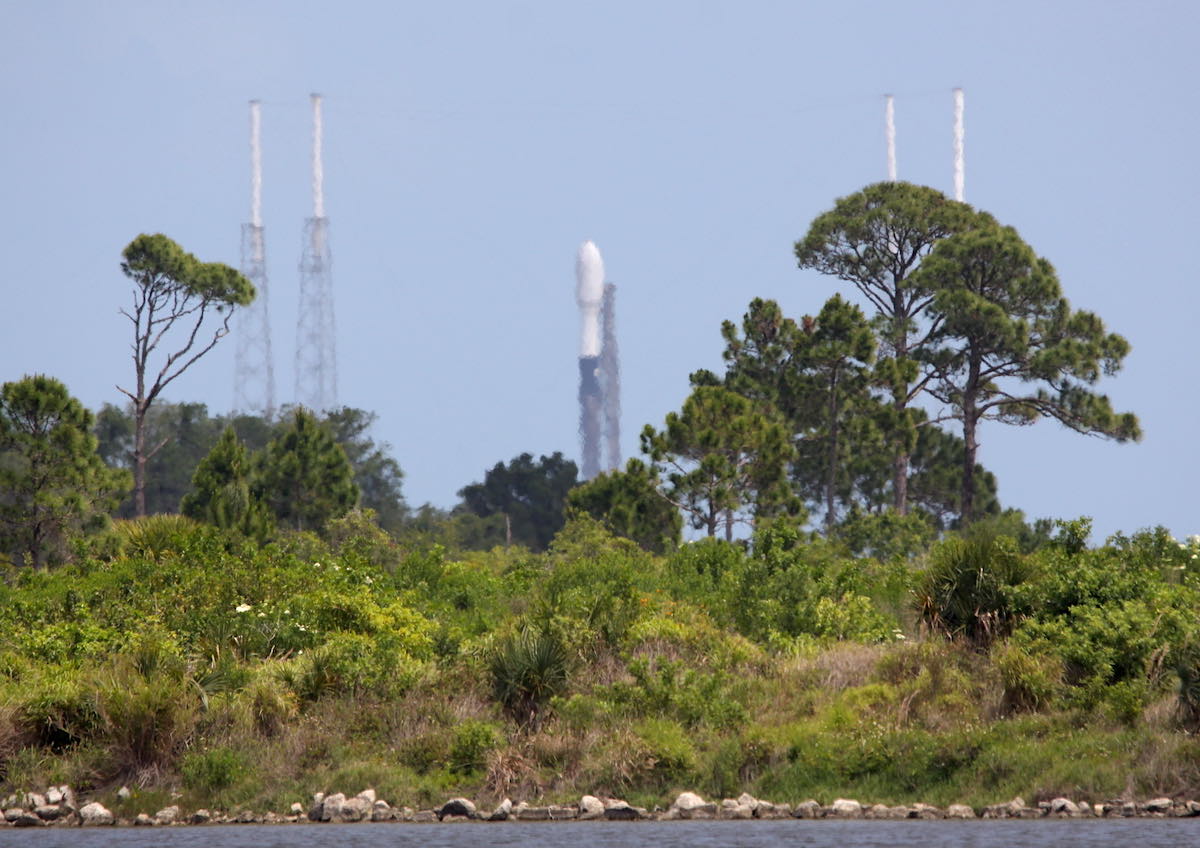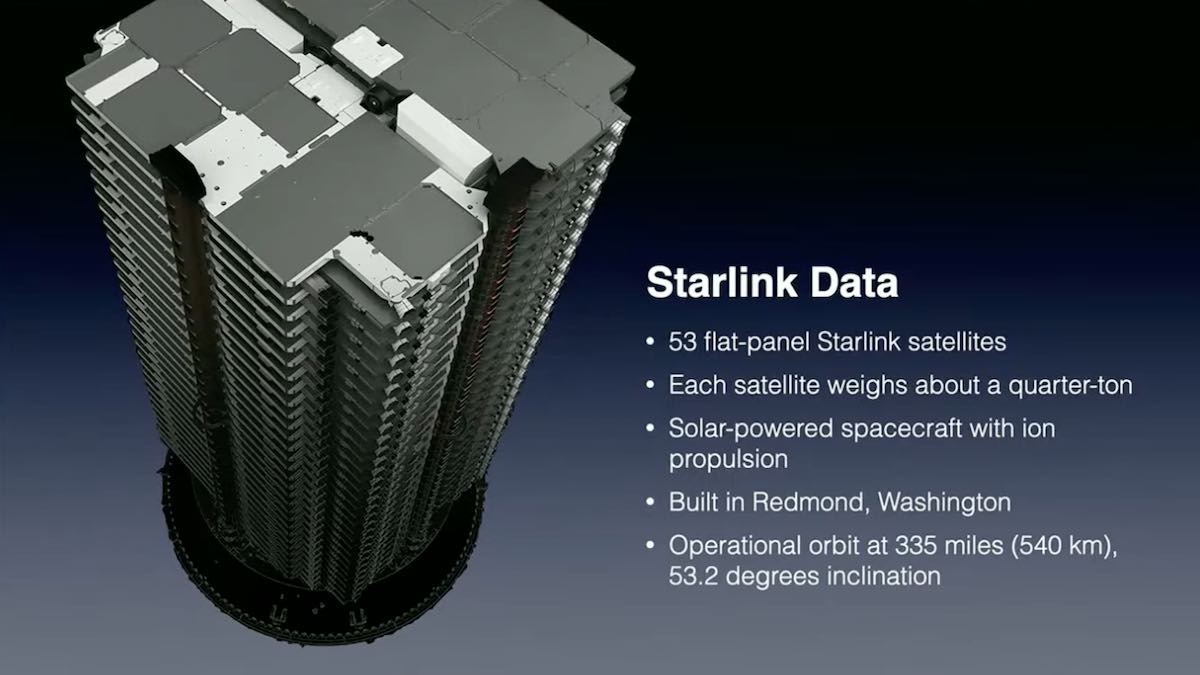Space News & Blog Articles
SpaceX to continue Starlink network deployment with Thursday launch
 File photo from April of a Falcon 9 rocket standing on its launch pad at Cape Canaveral Space Force Station. Credit: Stephen Clark / Spaceflight Now
File photo from April of a Falcon 9 rocket standing on its launch pad at Cape Canaveral Space Force Station. Credit: Stephen Clark / Spaceflight Now
Fifty-three more Starlink internet satellites are fastened to the top of a SpaceX Falcon 9 rocket for liftoff Thursday from Cape Canaveral, the first of five Falcon 9 flights scheduled for July.
SpaceX has two launch opportunities available Thursday at 9:11 a.m. EDT (1311 GMT) and 10:30 a.m. EDT (1430 GMT). A 229-foot-tall (70-meter) Falcon 9 rocket will take off from pad 40 at Cape Canaveral Space Force Station and head northeast to place the 53 Starlink satellites into orbit.
The Starlink payloads, built by SpaceX in Redmond, Washington, are flat-packed inside the nose cone of the Falcon 9 rocket for the eight-and-a-half minute ride into orbit.
The launch Thursday is designated Starlink 4-21, and marks the 49th SpaceX mission primarily dedicated to launching satellites for the Starlink broadband network. SpaceX said in May it has more than 400,000 subscribers for the Starlink internet service, which is designed to eventually provide high-speed, low-latency connectivity anywhere in the world.
SpaceX is about halfway through the build-out of its first-generation network, which will number around 4,400 active satellites, according the company’s filings with the Federal Communications Commission. With the 53 satellites set for launch Thursday, SpaceX will have shot 2,759 Starlink spacecraft into orbit, including prototypes and decommissioned satellites no longer in service.
A tabulation by Jonathan McDowell, a respected expert tracker of spaceflight activity, showed SpaceX has more than 2,400 Starlink satellites currently operating in orbit. Around 2,030 satellites are providing commercial services, according to McDowell. That’s nearly five times more than any other satellite fleet.
SpaceX does not provide a regularly updated figure for how many satellites are in service.
So far, SpaceX has focused its Starlink service offering to homes and businesses using fixed antennas. The FCC announced June 30 that it approved SpaceX’s request to begin offering Starlink connectivity to customers on-the-move. SpaceX previously marketed Starlink terminals for RVs, but the antenna was designed for use while the vehicle was not in motion.
“Authorizing a new class of terminals for SpaceX’s satellite system will expand the range of broadband capabilities to meet the growing user demands that now require connectivity while on the move, whether driving an RV across the country, moving a freighter from Europe to a U.S. port, or while on a domestic or international flight,” wrote Thomas Sullivan, chief of the FCC’s international bureau.
The FCC also approved Kepler Communications, a Canadian company in the early phase of deploying its own satellite constellation, to provide connectivity to ships.
 Credit: Spaceflight Now
Credit: Spaceflight Now
SpaceX has signed deals with multiple air carriers to provide in-flight Wi-Fi for passengers, and now has approval from federal regulators to provide the service. Cruise ships, cargo vessels, private yachts, trucks, buses, and RVs are also target markets for SpaceX’s Starlink network.
The U.S. military is also a prospective customer for Starlink services. The military has conducted connectivity experiments with the Starlink fleet on airplanes, and Delta Air Lines has performed similar preliminary testing.
Customers can sign up for Starlink service online by paying a reservation fee and paying $599 for an antenna and modem. SpaceX charges $110 per month for consumer-grade Starlink service, and an additional $25 per month for the ability to relocate Starlink antennas on vehicles like RVs.
SpaceX hasn’t disclosed prices for mobile customers.
The launch Thursday will head northeast from Cape Canaveral to place the 53 Starlink payloads into an orbit inclined 53.2 degrees to the equator, one of five orbital “shells” that make up the first-generation Starlink network.
The Falcon 9’s first stage booster, tail number B1058, will detach from the upper stage about two-and-a-half minutes after liftoff to begin a descent toward one of SpaceX’s drone ships in the Atlantic Ocean east of Charleston, South Carolina. The booster will be making its 13th flight to space, tying a record for SpaceX’s fleet of reusable rockets.
The upper stage’s single Merlin engine will fire about six minutes to inject the Starlink satellites into an elliptical, of oval-shaped transfer orbit. Separation of the Starlink satellites from the Falcon 9’s upper stage is scheduled for T+plus 15 minutes, 30 seconds.
The satellites will unfurl solar panels and activate krypton-fueled ion engines to climb to their operating altitude about 335 miles (540 kilometers) above Earth.
The launch Thursday — the 28th SpaceX mission this year — is the first of five Falcon 9 missions scheduled for July. They include three more Starlink missions later this month, plus the launch of a Dragon cargo ship to the International Space Station on July 14.
This email address is being protected from spambots. You need JavaScript enabled to view it. the author.
Follow Stephen Clark on Twitter: @StephenClark1.
When you subscribe to the SpaceZE News Feed, we will send you an e-mail when there are new updates on the site so you wouldn't miss them.

